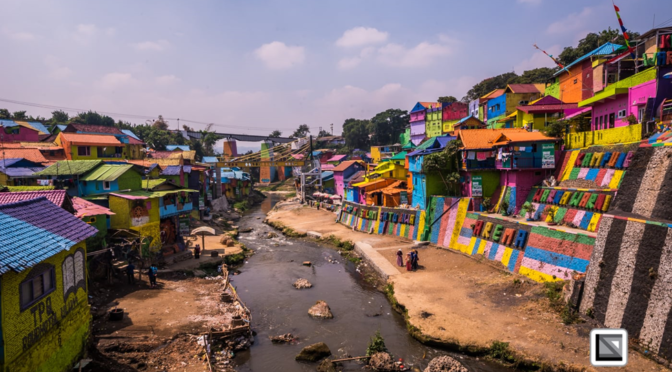The residents of Kampung Warna Warni set an example of using tourism to improve their livelihoods and environment
By Gerlin Leu
Introduction
Kampungs in Indonesia are urban informal settlements that lack adequate infrastructure, proper sewage systems, and paved roads. When I arrived in Indonesia for my study abroad in 2018, I was told to stay out of kampungs because they were seen as risky and undesirable. Yet, the first destination my host family took me to was Kampung Jodipan, a special kampung transformed for tourism. I came to learn that kampungs are vibrant communities with strong social ties where people work together in informal economies and find creative ways to resist formal planning policies.
Located near the loud train tracks and trash-dotted river of Malang in East Java, Kampung Jodipan was once infamous for environmental problems and poverty. The Malang city government aimed to relocate inhabitants to subsidized housing, thus cleaning up the riverbank and eradicating the “pathological” (Kamete, 2012) slum problem. This proposal was a classic example of planning processes framed by Western rationalities, whereby authorities define a place as a slum and see it as their responsibility to regulate and police the residents (Escobar, 1996; Roy, 2011) in order to formalize the urban.
However, in 2016, a group of communications students from the Universitas Muhammadiyah Malang created a kampung upgrade project to turn Jodipan into Kampung Wisata Warna-Warni Jodipan, “the Colorful Tourism Village of Jodipan.” As part of their mandatory school project, the students came up with the idea to “beautify” the village, and the Corporate Social Responsibility departments of local paint companies donated paint to support the project.
Analysis
The residents of Jodipan who accepted the services of the students and the assistance from the paint companies should not be seen as passive recipients of aid. Even though the project started under formal structures, it quickly evolved to a community-driven format where the community members took advantage of their agency to make decisions and directly profit from the tourism-driven transformation. For example, the residents proposed to paint the village multiple colors instead of one. They organized groups of housewives and community meetings to plan the logistics of the tourism program, including how to regulate the flow of visitors and what to charge for admissions. Unemployed community members set up coffee stands to capture the increasing trade provided by tourists and photoshoot opportunities to generate additional income. The formality of the planned spaces became blurred as new businesses emerged to cater to residents. These citizen initiatives can be understood as an example of everyday urbanism, as described by Addo (2024) in the case at the Accra Airport in Ghana.
Since its colorful transformation, Kampung Warna-Warni Jodipan has become a prominent, attractive tourism destination. Community members charge a small fee of Rp. 2000 (US $0.13 as of November 2024) to enter the village, where locals and tourists alike can snap attention-grabbing social media photos of its rainbow streets and creative Malang-centric murals by local artists. The ticket sales directly benefit the community, with 80% of revenues going to maintenance of the community infrastructure and 20% to fund the local waste management program. Before the project, the river that runs between Kampung Jodipan and the neighboring Kampung Tridi (also turned into a painted-blue village) was littered with household trash. Colloquially, people referred to the communities as “kampung kumuh” (trash villages). Now, the villages have waste management services as well as a new park and bridge constructed with revenues generated by the tourism project.
Despite its new tourism identity, Jodipan remains a bustling community. There is worry about tourists intruding into the private spaces of the residents and the commodification of “poverty,” but anecdotally, residents have welcomed the attention and are eager to share their lives with strangers. The paid structure and a designated tour route also help alleviate the tourist and public divide. Overall, happiness analysis research shows Jodipan residents to be happier overall with their status as a tourism village. The community has done more since the tourism status to preserve oral culture and religiosity, maintaining mental and physical health, solidarity, togetherness, and caring for others.
Implications
The “rainbow village” tourism model is not unique to Jodipan. From South Korea to Brazil, colorfully painted houses in low-income communities are frequented by tourists and gain media attention. However, Jodipan is heralded across Indonesia as a model of success due, in large part, to the community’s deep involvement and participation in the development of the tourism economy. Already before the project, residents had a strong connection and sense of belonging to the community. These intangible place-based values were the basis for their place attachment, as described by Shamsuddin and Ujang (2008), and served as crucial motivation to improve their community.
This case is an example of how residents can develop “invented” spaces of citizenship to assert their agency in the planning process. As Miraftab (2004) describes, “invented spaces” are spaces occupied and claimed by grassroots movements through collective action, while “invited spaces” are spaces legitimized by authorities. When the project first started, it was guided by state planners operating via invited spaces to mesh the kampung residents into the city development formula. With active community participation and organizing, however, the community developed an invented space where they could make decisions about how to upgrade their surroundings while claiming their right to stay. This is an optimistic example of tourism development that returns benefits to the community, serving as a model for forms of economic development that can improve environmental and economic conditions in low-income, informal settlements.

View of Kampung Warna Warni with the river. Source: https://claudiosieberphotography.com/countries/indonesia/malang-jodipan-and-tridi-village/

Kampung Warna Warni before the renovations. Source: https://claudiosieberphotography.com/countries/indonesia/malang-jodipan-and-tridi-village/

Glass bridge built for tourism. Source: https://discoverindonesianow.wordpress.com/2019/01/12/travel-destination-kampung-warna-warni-jodipan-malang-east-java-kwj/

History of the development plans, on display at the entrance. Source: https://discoverindonesianow.wordpress.com/2019/01/12/travel-destination-kampung-warna-warni-jodipan-malang-east-java-kwj/

Volunteers from the paint company working. Source: https://guyspro.wordpress.com/2016/08/28/first-blog-post/
